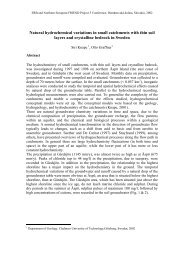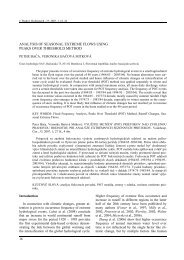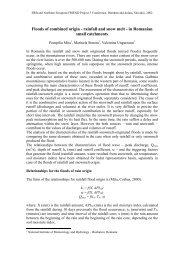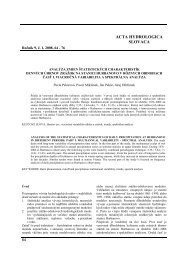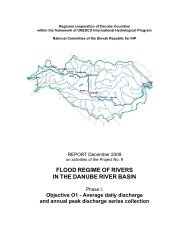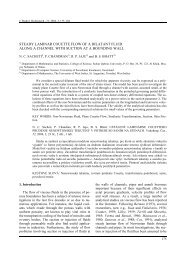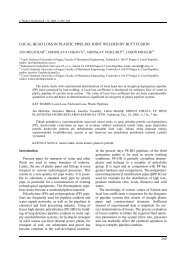TIME SERIES ANALYSIS OF HYDROLOGIC DATA FOR WATER ...
TIME SERIES ANALYSIS OF HYDROLOGIC DATA FOR WATER ...
TIME SERIES ANALYSIS OF HYDROLOGIC DATA FOR WATER ...
You also want an ePaper? Increase the reach of your titles
YUMPU automatically turns print PDFs into web optimized ePapers that Google loves.
Time series analysis of hydrologic data for water resources planning and management: a reviewwas found to cause a significant positive trend inthe total precipitation contributed by heavy precipitationevents (i.e., daily precipitations >25 mm and>50 mm). Furthermore, the trend was mainlycaused by past 60–80 years, and was particularlyevident during the periods of 1930 – 1945 and 1975– 1995.Molénat et al. (2000) analyzed the hydrologicaland hydrochemical behaviour of three agriculturalcatchments located in different regions of France(Kervidy, Melarchez and Mercube). The time serieswere considered as input or output data and thespectral analysis was performed. The input data forhydrology and chemistry were respectively rainfalland nitrate leaching, and the output data werestreamflow and nitrate concentration in the stream.It appears that nitrate concentrations measured atthe outlet of the three catchments exhibit a strongand unique one-year periodicity. This periodicity isdue to the hydrological regime and the time distributionof the nitrate availability in the soil. Moreover,a cross-spectral analysis was performed betweenthe input and output data for each catchmentand the major processes that govern water and nitratetransfer and the characteristic time scale ofthese processes were identified. It was concludedthat the spectral and cross-spectral methods arevaluable techniques for identifying the main transferprocesses operating in different catchments.Brunetti et al. (2001) analyzed the seasonal andannual precipitations and the number of rainy daysin northeastern Italy during 1920 – 1998. The precipitationintensity was analyzed by using both themean precipitation amount per wet day and dividingthe precipitation into heavy and non-heavyclasses. In addition, the return period of extremeevents was calculated for the 30-years and its variationswere examined. The results indicated a negativetrend in the number of wet days associated withan increase in the contribution of heavy rainfallevents to the total precipitation. This finding is inagreement with the reality (i.e., a reduction in thereturn period of extreme events since 1920).Kripalani and Kulkarni (2001) prepared regionalrainfall anomaly time series using the 118-year(1881 to 1998) data of three regions, India, northernChina and southern Japan. All the three series (India,China, and Japan) were subjected to selectedstatistical tests. The analysis of the results revealedthat though there are year-to-year fluctuations inrainfalls, the Mann-Kendall Rank statistic suggestedno significant long-term trends. However,the application of the Cramer's statistic to study theshort-term climate variability depicts decadal variabilitywith certain epochs of above and belownormal rainfall over each region. The epochs tendto last for about three decades over India andChina, and about five decades over Japan. The turningpoints for China follow those of India afterabout a decade.Adamowski and Bougadis (2003) estimatedtrends for different durations of annual extremerainfall by using the regional average Mann-Kendall S Trend Test. The method of L-momentswas employed to delineate homogeneous regions.The trend test was modified to account for the observedautocorrelation, and the bootstrap methodwas used to account for the observed spatial correlation.Numerical analysis was performed for 44rainfall stations in Ontario, Canada for a 20-yeartime frame using the data from homogeneous regions.Depending on the rainfall durations, four andfive homogeneous regions were delineated. At the5% significance level, approximately 23% of theregions tested had a significant trend, predominantlyfor short-duration storms. The serial dependencywas observed in 2-3% of datasets and the spatialcorrelation was found in 18% of the regions.The presence of serial and spatial correlation wasfound to have significant impacts on trend determination.Xu et al. (2003) detected long-term trends in thespatially averaged Japanese precipitation time seriesby applying the parametric t-test and the nonparametricMann-Kendall and Mann-Whitney tests.The results indicated that despite several stepchanges in the Japanese precipitation, the time seriesdid not exhibit significant evidence of monotonictrend during the past century. Further, it wasfound that if the magnitude of the step changereaches one or two times of its standard deviation,the previous 50-year records together with 5 yearsor more new data will be available for detecting thepossible trend. This finding is useful for the detectionof step changes in the regions where the precipitationhas near-normal distributions.5.2 Air and water temperatureEsteban-Parra and Castro-Diez (1995) analyzedthe longest annual and seasonal series of maximum,minimum and average temperatures of some localitiesin Spain. The homogeneity was checked byusing the Thom and Bartlett tests. These methodsare reported to yield different results in some cases.The analysis was performed to explore how the245



